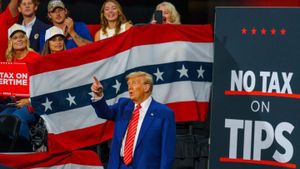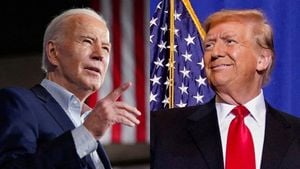The education policy framework of the United States has been far from stagnant over the past few years, particularly under the turbulent administration of Donald Trump. The contours of public discourse surrounding student loans and relief options have shifted dramatically, spurring both hope and concern. With Biden's administration attempting to roll out wide-ranging debt forgivable plans, the past presidency of Trump has brought considerable debate over the future of such initiatives. The crux of the matter revolves around whether Trump's policies will shape long-term changes to how student loans are managed and what recourse borrowers will have going forward.
During his time as president, Donald Trump proposed significant alterations to the Department of Education, criticizing existing structures. His view was not merely to question specific policies but rather to challenge the very essence of federal engagement with education. This ideological battle over the role of the federal government came back to the spotlight with his continuing influence on Republican educational reform agendas, which frequently criticized existing student debt alleviation measures.
Trump's administration marked its territory with policies aimed at reducing the federal role within education. He argued against programs initiated under President Obama aimed at easing the burden on student loan borrowers, asserting these benefits disproportionately favored the wealthy. This narrative would push the dialogue on educational finance toward more conservative principles, ranging from skepticism about federal bailouts to broader concerns over the sustainability of student debt forgiveness schemes.
With Biden's administration, the stakes have continued to evolve. His ambitious debt relief strategies, which aim to assist low- and middle-income borrowers, have faced significant backlash from conservatives who echo Trump's sentiments about wealth distribution. Critics argue programs such as these enable wealth transfer from taxpayers to borrowers, threatening social equity and financial responsibility.
So, where do things currently stand? According to recent reports, many borrowers are bracing for higher monthly payments as moratoriums on student loan repayments are set to end. The Biden Administration's proposals might alter fiscal strategies for borrowers; nevertheless, they remain uncertain under the cloud cast by Trump's enduring legacy.
From the onset of Trump's presidency, by proposing to dismantle the Department of Education, he raised questions about the feasibility of any wide-reaching federal debt relief programs. Trump's criticism of Obama-era reprieves set off alarms about potential shifts away from forgiveness programs, leading many to wonder if postponing some of these proposals would become standard practice.
Trump's administration saw the rollback of several key provisions intended to alleviate borrower debt, which curtailed the introduction of new initiatives. The Federal Family Education Loan Program was one such area where prior reforms underwent substantial scrutiny. The issue of how forgiving these loans will come to fruition, all hinged on the political scene, remains murky.
While Trump's approach typically leaned toward privatizing education and placing accountability on borrowers rather than institutions or the government, Biden’s plan aims to regenerate support for urban and underprivileged students. The struggle between these differing ideologies reflects broader national dialogues surrounding the philosophy of education funding and eligibility requirements for federal aid.
Are students simply burdened by debts amassed from attending institutions promising high returns on education? Or did administrative decisions meant to aid students inadvertently lead to taxpayer backlashes? These questions echo across campuses, spurring active discussions among students and policymakers alike.
The upcoming elections might be pivotal for not just student loan policies but for the Department of Education itself. Potential candidates, buoyed by Trump's past, spark interest among conservatives who seek to carry forth his educational agenda. Dismantling established systems could reignite policies directly impacting student access to affordable education.
Advocates for student loan reform have long battled for the relevance of their issues and have consistently pushed for nuanced approaches to assist borrowers facing financial burden. The silence from the highest echelons of political power around these issues serves to frustrate advocates and resurrect calls for transparent and accessible solutions.
Experts warn achieving bipartisan acknowledgement for radical structural changes remains exceptionally challenging. If the Department of Education is threatened with elimination or severe budget cuts, looming complications for borrowers could worsen financial predicaments.
What's abundantly clear is the intersection of Trump’s policies and the resulting burden many current student loan holders will need to navigate. While Biden’s relief efforts evoke renewed hope, they are deeply embedded within bipartisan strife and uncertainty. Borrowers stand at the precipice of a collapsing repayment system, embroiled between conflicting political doctrines and and emphatic discussions about the very nature of public support.
What’s more, outside the political sphere, the conversations at universities, campuses, and among student advocacy groups continue to grow louder. Students demand more clarity about their futures and whether help is forthcoming or if the burden they carry is destined to intensify. Will affordability and accessibility give way to competitive pricing models dictated by market demands, leaving average students with little recourse?
Trump’s educational reforms might not just represent immediate conflicts but could be the threshold of generational shifts toward education financing. The entangled histories of these policies serve to remind individuals of their shared journeys, shaped by the summation of regulatory changes, public expectations, and the murmurs of students demanding their rights.
The uncertainty around repayment programs is matched only by the fervent passion of those who strive to win back dignity amid the struggle against educational debt. Indeed, the path forward remains congested. Voters, students, and educators alike watch closely, seeking clarity among rhetoric and reality.
With November elections on the horizon, the dynamism of these issues remains ever-present. Federal policies on education financing, restructured or remaining the same, will provide insight and clarity—not just for the present generation of students but for the future of education policy as it evolves. The conversations surrounding student loans are far from settled; they are imbued with hopes, fears, and expectations reminiscent of previous elections. It leaves the American populace questioning how much these educational policies will truly change at the core of their everyday lives.



